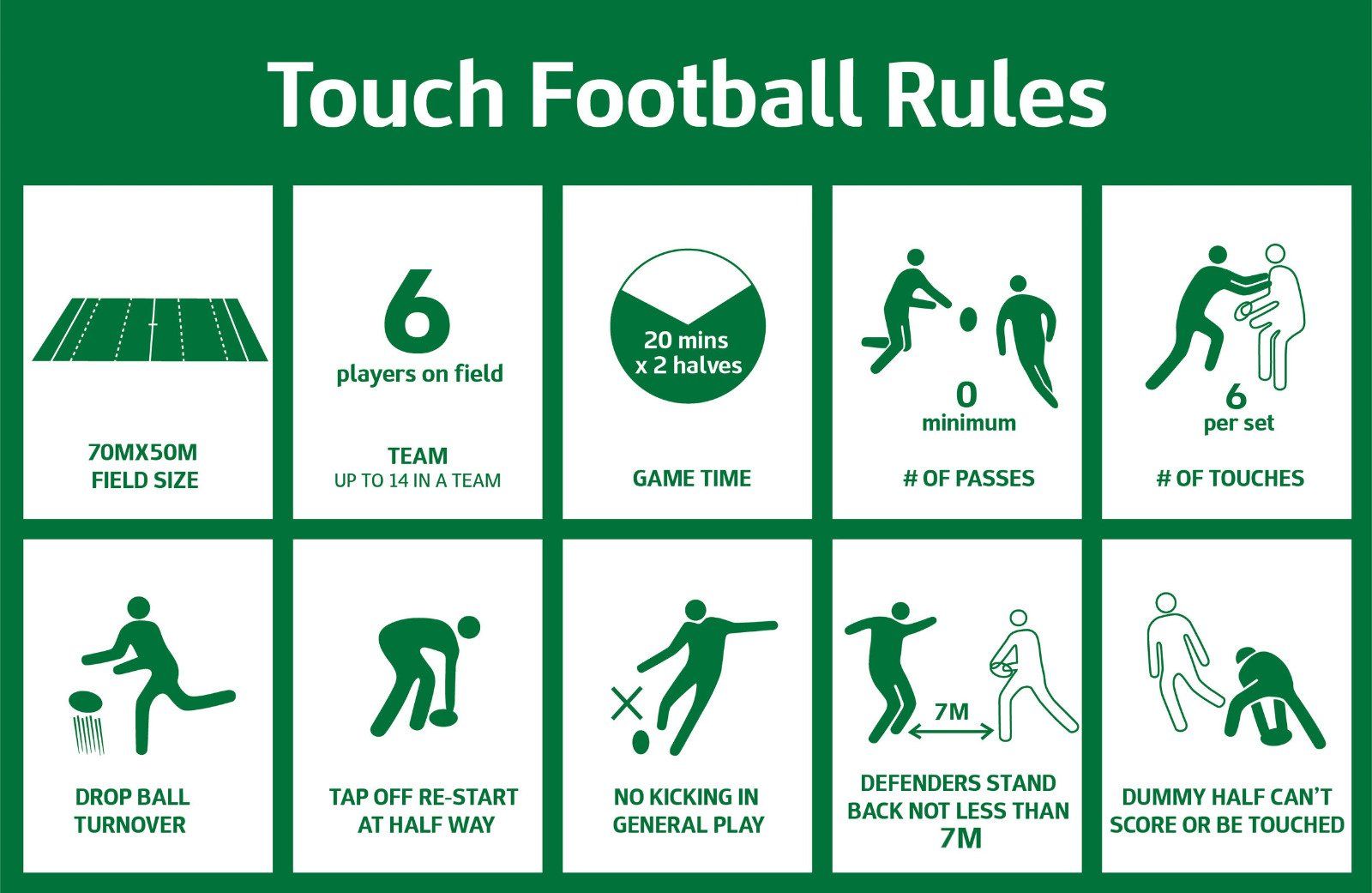RULES OF THE GAME
Goal
The aim of the game Touch Rugby is for your team to score more Try's than your opponents.
Teams
Teams can consist of up to 14 players with a maximum of six players on the field at a time.
Teams must move the ball across the field into the opponent's "Try zone" without:
- Pass the ball forward Drop or kick the ball
Each attacking team has six “Touches”. On the sixth touch, the ball goes to the opponent.
When an attacker is touched, he/she must perform a “Roll Ball” at the point of contact (unless it is the sixth touch - then possession changes to the other side). You do not have to use your foot to roll the ball. The defending team may move forward once the Dummy Half's hands are on the ball.
The Dummy Half may run with the ball, but may not score or be touched. If this does happen, the team loses possession and the ball goes to the opposing team who then resumes the match with a "Roll Ball".
Defenders must move back at least seven meters when an attacker Dumps the ball (Roll Ball) on a Touch, otherwise he/she is "Offside". Any violation will result in either a reset of the "count" (6 Touches). When a penalty is awarded, possession of the ball is given to the non-offending team and they are instructed to perform a "Tap Ball" at the spot/mark indicated by the referee. In most situations it will be where the violation occurred.
A "Tap Ball" is used to start play at the start of a match, resume play after half time or after a Try. A Tap Ball is also taken by the team awarded a penalty.
How to take a Tap Ball:
- Place the ball on the spot assigned by the referee Release the ball Tap the ball with your foot (no further than 1 meter) Pick up the ball.
The defending team may only move forward once you have tapped the ball with your foot.
Penalties
- Forward Pass Touch and Pass Offside Comment to the referee Off the Mark Dumping the ball where you have not been touched
The Ball
The game is played with an oval, inflated ball: the ball is 36 cm long and 55 cm in circumference (slightly smaller than a size 4 rugby ball).
Shoes
Shoes with removable studs or cleats may not be worn. Light leather or synthetic sports shoes with soft molded soles are permitted.
Jewelry, fingernails and other items
Players are not allowed to play while wearing any jewelry, necklace or similar item that could be dangerous. Long or sharp nails are not allowed. Items that cannot be removed, or dangerous fingernails, should be taped.
Players may wear glasses or sunglasses provided they are securely and securely attached. Although this is strongly discouraged! Medical supports such as knee or ankle braces may also be worn, provided they are not harmful.
Field markers
Suitably sized markers or cones of a distinctive color and made of safe and pliable material shall be placed at the intersections of the sideline, centerline and Try line.
Basics of the game
Game overview
The main objective of the game is for each team to score Try's and prevent the opponent from scoring (One try equals one point). Teams consist of 6 players on the field at any time, with up to 8 substitute players on the sidelines. The teams are divided into boys (men), girls (women) and mixed divisions (mixed = 3 male 3 female players). Players can switch at any time during the game and as often as they want.
Teams both attack (when they have possession of the ball) and defend (try to prevent the other team from scoring). Attacking players must perform a 'Roll Ball' (between the legs) after being touched by a defender. Defenders must retreat in a straight line 7 meters from the 'Roll Ball' marker. After 6 Touches, possession of the ball changes to the other team. Penalties are awarded for a variety of offenses including Forward Pass, Offside, Touch-and-Pass, Roll Ball over the Mark and Over-Harding Play.
General game principles
On the attack
The aim of the game is to score more Try's than the opponent; this is achieved by moving to the opponent's Try line. Sometimes it can be tactically advantageous to move to the sideline to gain more space for further attacking impulses.
Support the ball carrier at all times
Close support of the ball carrier offers more attacking options and means possession can be maintained. Close support also means that no ground has to be lost by having to pass the ball far back to a teammate. Remember that a pass directly to the side is allowed and can often be the most effective pass.
On the defensive
When defending, try to deny your opponents time and space by moving forward and touching. The faster you move forward against the attacking team, the less progress they will make towards your try-line.
Switch players as much as possible
A fresh set of legs on the field can be the difference between winning and losing. Look to switch your players while attacking and in the substitution area. Once you've made a Try, it's good to swap in a whole new set of players to keep the intensity up.
From Touch
Any part of the person, clothing or ball is a valid Touch.
After a touch has been made, the player in possession of the ball must stop and possibly return to the spot where the touch occurred if the mark has been crossed. Repeat the game by then performing a Roll Ball. Failure to do so by the player in question will result in a penalty for "Off the Mark".
After being touched 6 times, the ball goes to the opponent.
If a touch is deemed too hard, a penalty is awarded to the attacking team.
The Dummy Half (the person who receives the ball from the player after a Dump or Roll Ball) may not be touched while in possession of the ball. If the Dummy Half is touched with the ball, possession is transferred to the opponent, who will resume play with a Roll Ball.
Roll Ball
The Roll Ball is accomplished by the attacking player positioning themselves on the mark, facing the defenders' Try line, parallel to the sideline and rolling the ball backwards along the ground between their feet. If the ball is rolled more than 1 meter, a foul is awarded in favor of the opponent.
Penalty
If someone is punished with a Penalty against, his team must always retreat 10 meters. A penalty is taken by performing a "Tap Ball".
Passing
A 'Forward Pass' is when the ball is passed in front of the player who was in possession of the ball. In this situation the referee will award a penalty in favor of the defending team. A 'Touch and Pass' is when the person being touched passes the ball. Here too, the attacking team will be punished with a penalty against.
Offside
A defensive player is offside if he/she has not walked back at least 7 meters after making a touch. If the defender in question does not walk back 7 meters, but does move forward, he/she will be penalized with a Penalty against for Offside .
Jargon buster
A “touch” is contact on any part of the body between the player in possession of the ball and a defending player. A touch includes contact on the ball, hair or clothing and may be made by either the defending player or the player in possession.
A “roll ball” is the normal act of bringing the ball into play following a touch or a change of possession. To perform a roll ball:
- Face your opponent’s scoreline and stand parallel to the sidelinesPlace the ball on the groundStep over the ball
The “Dummy Half”, or “The Half”, is the player who takes possession of the ball behind the player who performs a roll ball.
A “touchdown” or "Try" is the result of an attacking player, in possession of the ball (and who is not the half), placing the ball on or over the team’s attacking scoreline prior to being touched by a defender. Touchdowns / Tries are worth 1 point.
Offside
Defending Team
If a roll ball is being performed by the attacking team, defending players must retreat a distance of at least 7 metres from the mark where the touch was made.
If a tap is being performed by the attacking team, the defending team must retire at least 10 metres.
The referee will indicate where the defending team must retire to and defending players who do not retire the correct distance will be “offside”, and may be penalised if they interfere with the attacking play.
Attacking Team
An attacking player is considered offside if they are in front of the player in possession of the ball. Other than when their team is performing a tap, an attacking player can remain offside without penalty as long as they do not interfere with defending players.




